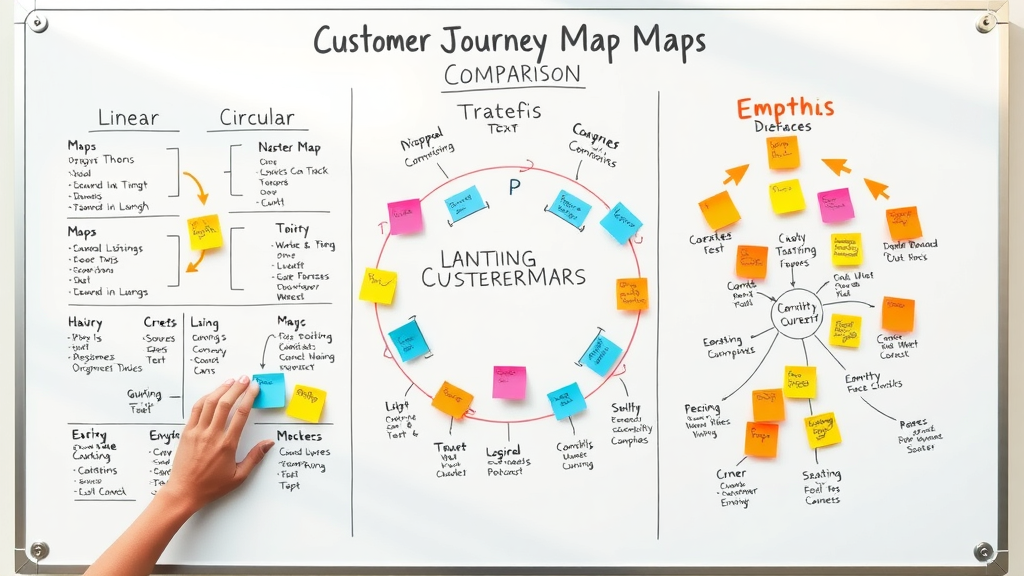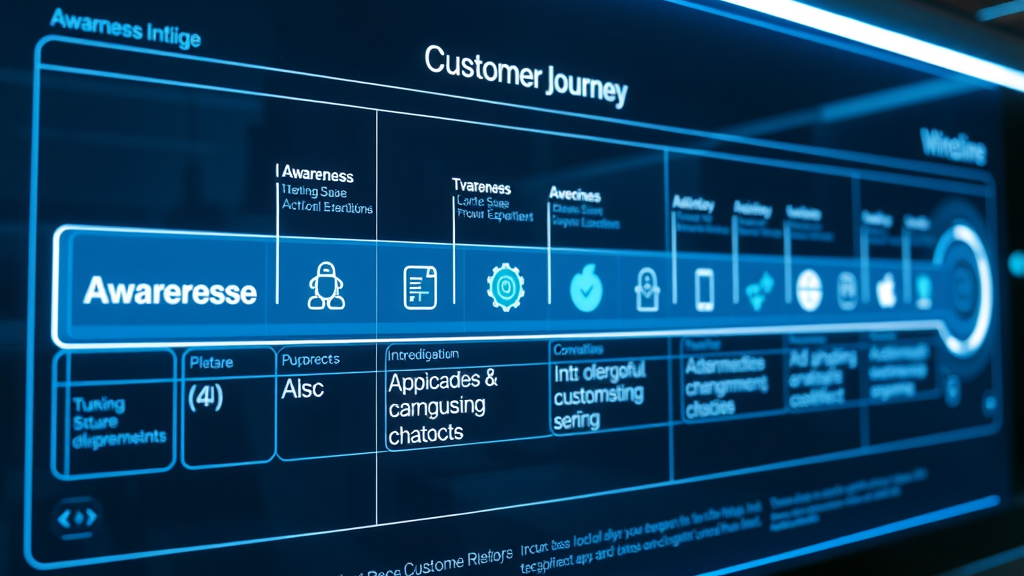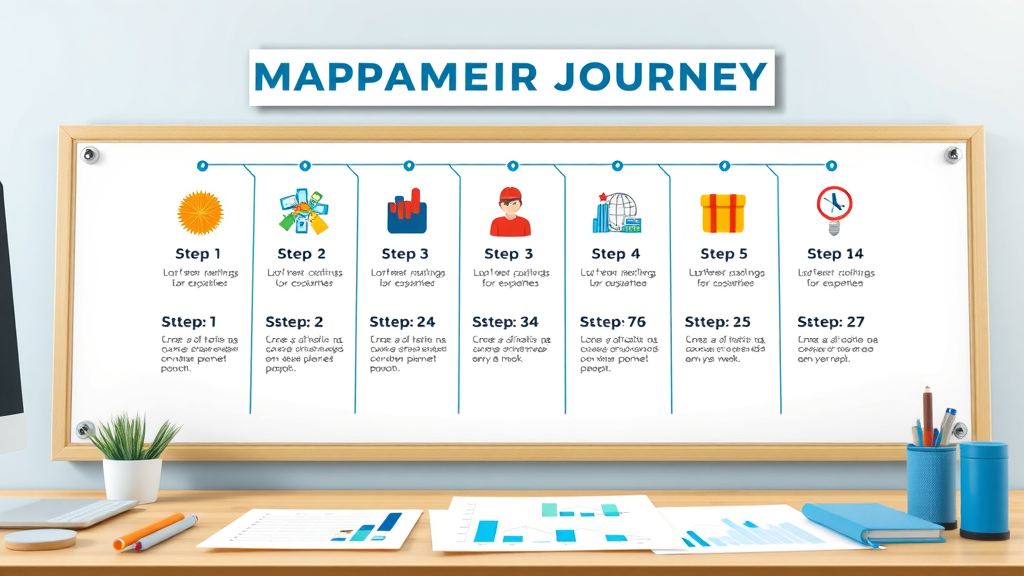Did you know that 86% of buyers are willing to pay more for better customer experience ? Yet, most businesses overlook the invisible roadblocks preventing customers from becoming loyal advocates. Mapping your customer journey isn’t just a buzzword—it’s the secret ingredient fueling sustainable growth. In this comprehensive guide, you’ll discover why customer journey mapping is pivotal for success, with actionable frameworks, expert advice, and case studies showing exactly how leading brands map the path to explosive results.
Harness the Customer Journey for Growth: Why Every Business Needs Customer Journey Mapping
- 86% of buyers are willing to pay extra for an exceptional customer journey and experience—making it a direct driver of revenue ( customer experience ).
- A clear customer journey map reveals hidden pain points, new service opportunities, and moments to delight customers, which opens pathways for explosive growth.
- Companies like Amazon, Netflix, and small SaaS startups have revolutionized their growth trajectories by skillfully mapping and optimizing the entire customer journey.

"If you don't map your customer's journey, your competitors will map your failure." – Industry Thought Leader
What You'll Gain from Mastering the Customer Journey
- Foundational understanding of the customer journey and journey maps
- A step-by-step guide to successful customer journey mapping
- Tips for identifying pain points and enhancing customer service
- Ways to leverage customer feedback and buyer personas
- Framework for sustainable growth using journey mapping strategies

Decoding the Customer Journey: Terms, Benefits, and Core Concepts
What is the Customer Journey?
The customer journey is the complete storyline of how customers interact with your brand—from hearing about you for the first time to becoming loyal advocates. Every touchpoint, from social media ads to website visits and customer support chats, forms part of this journey. By mapping these interactions, companies can see the buying process through their customers’ eyes, identify pain points, and create moments of delight that lead to increased customer loyalty and business success.
To truly understand the customer , brands need to appreciate that each journey is unique. The customer journey isn’t just a series of transactions—it's a multidimensional experience shaped by expectations, emotions, and brand promises. By focusing on the entire customer lifecycle, rather than just single stages, companies can make targeted improvements that boost customer satisfaction and revenue. Mapping this journey makes it easier to spot gaps that undermine the experience, turning potential customers into lifelong fans.
In practice, businesses use journey maps to track every customer interaction, from awareness to post-purchase support. These maps become invaluable assets for identifying what motivates potential customers to make a purchase, what obstacles cause them to drop off, and how to address pain points proactively. The result is not just an improved customer experience but a blueprint for measurable business growth.
Customer Journey Map: Visualizing the Customer Experience
A customer journey map is a visual representation of the entire customer experience, tracing every interaction a customer has with your brand. These maps help businesses pinpoint the most critical moments in a customer's relationship—good or bad. A journey map isn’t just a document; it’s a strategic tool used to improve the customer experience, as it highlights gaps, reveals pain points, and unlocks new opportunities for delight.
Through journey maps , teams gain a shared understanding of where customers struggle, what excites them, and when they need support. Whether you’re a retailer mapping store visits or a SaaS company refining onboarding, a well-designed journey map centralizes customer data, customer feedback, and real-world observations. This clarity drives cross-functional collaboration, ensuring marketing, sales, and customer service departments align on strategies that deliver value at every stage.
Ultimately, a robust customer journey map helps companies deliver a seamless, consistent, and positive customer experience. It gives decision-makers a data-driven foundation to prioritize investments, refine touchpoints, and tailor communications, thereby nurturing stronger relationships and increasing customer loyalty.
Journey Mapping: From Data to Insights
Journey mapping is the systematic process of gathering, analyzing, and visualizing all customer interactions across various channels and stages of the buying process. Unlike assumptions or gut feelings, journey mapping relies on hard data and real customer feedback to uncover hidden patterns, unmet needs, and critical pain points in the customer journey.
By leveraging data from every touchpoint, from website analytics to social media engagement and customer service interactions, journey mapping translates information into actionable insights. The methodology typically involves creating buyer personas, mapping out customer emotions, and identifying both moments of frustration and moments of delight. Armed with these insights, teams can prioritize fixes that will have the greatest impact on customer satisfaction and business results.
The end goal of customer journey mapping is continuous improvement. By regularly updating journey maps with new data and feedback, businesses stay ahead of changing customer expectations and competitive threats. This ongoing optimization lays the groundwork for sustained growth and differentiation in saturated markets.
| Aspect | Customer Journey | Customer Journey Map | Customer Journey Mapping |
|---|---|---|---|
| Purpose | Understand the complete customer experience | Visual representation of the journey | Systematic process to uncover and improve touchpoints |
| Outputs | Insights about stages and emotions | Maps, diagrams, empathy maps | Action items, insights, prioritized improvements |
| Benefits | Customer-centricity, loyalty, retention | Alignment across teams, improved experience, accountability | Continuous optimization, innovation, competitive advantage |
"A customer journey map isn’t a guess; it’s a data-driven blueprint for growth." – CX Specialist

Exploring the Customer Journey Map: Frameworks and Formats
Common Customer Journey Maps: Templates and Examples
- Linear Journey Maps – Steps unfold left to right, ideal for simple buying processes.
- Circular Journey Maps – Depict recurring cycles, perfect for subscriptions or loyalty programs.
- Channel-Specific Maps – Focus on one channel (e.g., mobile or social media) to analyze channel-dependent pain points.
- Empathy Maps – Capture customer thoughts, feelings, and motivations to enhance empathy and service at every step.
The format you choose for your customer journey map should match your goals. Linear maps are great for straightforward sales, whereas circular and empathy maps help with more complex, ongoing relationships. Regardless of template, each map must clearly highlight customer touchpoints, pain points, and moments of delight for maximum impact.
Leading businesses often use a combination of these map formats to ensure they’re addressing every element of the customer journey. For example, a retailer might use a linear map for the in-store journey and a channel-specific map to evaluate mobile shopping behavior. Empathy maps add a deeper emotional layer for service-led industries, helping to tailor customer support and messaging that resonates.

How Customer Journey Maps Enhance the Customer Experience
By visualizing the entire customer experience, customer journey maps empower businesses to identify and eliminate pain points that frustrate customers. This process not only improves the customer experience but also leads to higher conversion rates, better retention, and increased loyalty. Whether it's a confusing website navigation or slow customer support response times, maps provide a clear action plan for resolution.
When teams collaborate around a shared journey map, they develop a holistic understanding of how customers interact with a product or service. This alignment fosters smoother internal communication and enhances decision-making across marketing, sales, and support. Ultimately, mapping the journey ensures that no customer touchpoint is left unchecked, delivering a consistently positive brand experience.
Successful companies see their journey maps as living documents—constantly updated with real-time data and feedback. This proactive approach keeps businesses ahead of evolving customer expectations, helping them outpace the competition while strengthening their reputation for excellent service.
Key Elements of Effective Journey Maps
- Buyer Persona: A detailed profile representing your ideal customer, including demographics, motivations, and goals.
- Customer Personas: Segmented representations for different target audiences to ensure every journey is personalized.
- Customer Feedback: Direct insights from real customers, collected via surveys, chats, and support tickets.
- Identified Pain Points: Specific obstacles or frustrations at each stage of the journey, used to target improvements.
- Moments of Delight: Opportunities to exceed customer expectations and drive loyalty—like unexpected perks or seamless support.
Building effective customer journey maps is impossible without real data and a commitment to seeing the world through the eyes of your customers. By referencing personas and analyzing feedback, brands find not only where experiences break, but also where magic happens, helping them double down on the strategies that drive loyalty and advocacy.
Incorporating the above elements into your journey map ensures that each stage is actionable and results-oriented. From the initial attraction to post-purchase follow-up, your business gains a 360-degree perspective of the entire customer experience, setting the stage for impactful and lasting growth.

People Also Ask: What is the customer journey?
Answer: The customer journey is the complete sum of experiences that customers go through when interacting with your brand, from initial awareness to post-purchase engagement.
Every time potential customers encounter your brand—whether browsing your website, reading reviews, or reaching out to customer support—they’re navigating part of their customer journey . By analyzing this journey, you can discover exactly what influences their decisions, how to remove roadblocks, and how to turn interest into loyalty.
Understanding the customer journey is vital for refining marketing, sales, and customer service . It reveals the emotional ups and downs of the buying process and highlights where customers may lose interest or experience friction, making continuous improvement possible.
The Five Main Points of the Customer Journey: A Strategic Breakdown
- Awareness: The customer first becomes aware of your brand or product.
- Consideration: The customer evaluates options and weighs choices.
- Purchase: The decision to buy is made—this is where conversion matters.
- Retention: Ongoing engagement, support, and delivery that keep customers coming back.
- Advocacy: Satisfied customers become enthusiastic promoters, referring others and celebrating your brand.
Each stage represents a key opportunity to improve the customer experience and build loyalty. By segmenting your efforts, you can create targeted messaging and support at each step—ensuring nobody falls through the cracks.
For example, a customer may first hear about you through social media during the awareness phase, compare you to competitors during consideration, and decide to make a purchase after a seamless web chat. Retention efforts—like loyalty programs and helpful follow-up—drive repeat business, while advocacy transforms happy customers into brand ambassadors, further accelerating growth.

How These Stages Drive Customer Experience and Loyalty
Each stage of the customer journey represents emotional highs and lows that shape customer perceptions and actions. When businesses understand and map these stages, they can deliver proactive service, timely communications, and memorable experiences. A well-executed journey builds trust, increases customer loyalty , and fuels organic word-of-mouth growth—critical for both B2B and B2C companies.
This strategic lens lets brands measure which interactions create delight and which cause frustration. By prioritizing improvements at every stage, businesses ensure a smooth transition from potential customer to loyal advocate, turning the customer journey into a sustainable competitive advantage.
Organizations that embrace this approach outperform their peers: they enjoy higher NPS scores, better retention, and a larger share of wallet—proof that investing in every stage of the journey translates directly to business results.
| Customer Journey Stage | Objective | Key Metrics | Customer Emotions |
|---|---|---|---|
| Awareness | Generate interest and reach target audience | Reach, Impressions, Website Visits | Curiosity, Hope, Anticipation |
| Consideration | Build trust and provide information | Engagement, Time on Page, Sign-Ups | Confidence, Skepticism, Motivation |
| Purchase | Facilitate conversion and remove friction | Conversion Rate, Cart Abandonment, Sales | Excitement, Anxiety, Relief |
| Retention | Encourage repeat business and loyalty | Repeat Purchases, CSAT, Churn Rate | Satisfaction, Security, Appreciation |
| Advocacy | Activate word-of-mouth referrals | Net Promoter Score, Referrals, Reviews | Pride, Ownership, Enthusiasm |
"Mapping the customer journey stages reveals the key moments that matter most to your target audience." – Marketing Director
People Also Ask: What are the 5 stages of the customer journey?
Answer: The 5 stages are Awareness, Consideration, Purchase, Retention, and Advocacy, each essential for building long-term customer relationships.
Each stage gives your team a chance to influence outcomes. Focusing on these five points ensures that customers feel seen, valued, and supported, driving loyalty and growth over time.
By knowing what matters at every stage, you can design campaigns and experiences that attract, convert, and retain your most valuable customers, while encouraging them to spread the word about your brand.
How to Map the Customer Journey in 7 Actionable Steps
- 1. Define your buyer persona and target audience
- 2. Collect customer data and feedback across touchpoints
- 3. Identify customer pain points
- 4. Outline all touchpoints and channels in the buying process
- 5. Map emotional highs and lows
- 6. Validate with customer service teams and customers themselves
- 7. Continuously optimize the customer journey mapping process
To successfully map your customer journey , start by documenting who your ideal customers are and the challenges they face. Gather customer feedback through surveys, interviews, and data analysis to identify pain points. Next, catalogue every interaction—from social media to customer support—that shapes their experience.
By mapping emotional highs and lows, you reveal where customers feel most vulnerable or delighted. Collaborate with your customer service teams and test assumptions with actual customers, then update your journey maps continuously as feedback and behaviors evolve.

People Also Ask: How to map the customer journey in 7 steps?
Answer: The seven steps include understanding buyer personas, gathering feedback, pinpointing pain points, mapping every interaction, charting emotions, validating findings, and refining your journey maps regularly.
This systematic approach transforms abstract data into clear, actionable insights—giving your team a roadmap for ongoing improvement and customer-centric growth.
Best Practices for Customer Journey Mapping: Avoid Pitfalls and Maximize Impact
- Involve cross-functional teams in the journey mapping process to ensure a 360° perspective
- Focus on the customer experience , not just internal efficiency
- Update journey maps in real time with customer feedback
- Prioritize improvements at major pain points for maximum impact
Effective customer journey mapping is a team sport. When marketing, sales, and customer service collaborate, maps are more accurate and actionable. Always prioritize the customer’s outlook—the best journey maps solve real customer pain points, not just company bottlenecks.
To truly improve the customer experience , regularly update your journey maps with new data and feedback. This makes maps dynamic tools for growth, not static documents. By prioritizing pain points, you achieve the fastest wins and gain internal buy-in for further customer-focused innovation.
"The most successful businesses never stop improving the customer journey." – Customer Experience Expert

Case Studies: Brands Achieving Growth through Customer Journey Mapping
- How a SaaS platform reduced churn by mapping pain points—By identifying where customers were struggling in onboarding, the company streamlined tutorials, leading to a 30% boost in retention and a dip in support tickets.
- Retailer increases loyalty by personalizing touchpoints—Through detailed customer journey mapping, the brand deployed targeted SMS offers at optimal moments, propelling loyalty program sign-ups and frequent repeat purchases.
- B2B company leverages customer journey maps for improved onboarding—By mapping the full sales and implementation process, they personalized training and proactively addressed customer concerns, resulting in improved NPS scores and long-term relationships.
Each example shows the tangible benefits of mapping the entire customer journey . When companies actively resolve pain points and personalize interactions, the payoff is retention, higher satisfaction, and explosive growth.

The Role of Customer Feedback and Personas in Journey Maps
Gathering and Applying Customer Feedback
Direct input from your target audience is the backbone of accurate journey mapping . Collect feedback through surveys, support interactions, social media listening, and focus groups. This data uncovers the pain points, needs, and desires shaping the customer journey.
Use these insights to validate your journey map assumptions, ensuring every touchpoint accurately reflects the customer experience . Over time, ongoing feedback forms the basis for continuous optimization and innovation.
Remember: the most valuable insights often come from open-ended questions and candid opinions, revealing surprises you might have otherwise missed.
Developing Buyer Personas for Targeted Customer Journey Maps
A buyer persona is a semi-fictional representation of your ideal customer based on research and actual data. Personas highlight motivations, common pain points, preferred channels, and buying behaviors, serving as a compass when creating targeted customer journey maps .
By building personas for different segments, you ensure your maps (and improvements) resonate with each group. This strategic approach makes personalization possible, leading to better experiences—no matter the audience.
Comprehensive customer personas also make it easier to target content, support, and outreach, maximizing impact at every stage of the buying process.
Using Feedback to Improve the Customer Experience
Gathered feedback is only valuable when acted upon. Use the pain points and suggestions revealed through journey mapping to fuel real changes: streamline onboarding, tweak messaging, or enhance service channels.
By demonstrating responsiveness—updating touchpoints and thanking customers for their input—you build trust and encourage ongoing engagement.
The result is a customer base that feels heard and valued, leading to measurable increases in customer satisfaction , loyalty, and advocacy.

Enhancing Every Stage: Turning Pain Points into Opportunities
- Common pain points in the buying process include confusing information, slow response times, and lack of personalization.
- Addressing these with journey mapping helps businesses resolve issues swiftly and elevate the experience.
- Measuring improvements via customer satisfaction and retention metrics validates your strategy and delivers proof to stakeholders.
Resolving pain points is the shortest path to delight. By focusing on obstacles flagged by customer feedback and your journey maps, you unleash opportunities for upselling, referrals, and loyalty.
Use before-and-after customer satisfaction scores, retention rates, and direct testimonials to measure your progress. Where pain points once caused churn, transformed touchpoints become signature moments that keep customers coming back.
| Pain Point | Journey Stage | Resolution Strategy | CX Outcome |
|---|---|---|---|
| Long wait for customer service | Retention | Implement chatbots and proactive support | Improved satisfaction, less churn |
| Confusing onboarding | Purchase/Onboarding | Clear guides and in-app tutorials | Higher engagement, lower abandonment |
| Lack of personalized offers | Consideration/Retention | AI-driven recommendations, segment-based messaging | More conversions, repeat purchases |
| Unclear product value | Awareness/Consideration | Rich content, demo videos, testimonials | Increased trust, improved conversion |
Leveraging Customer Service for Transformative Journey Maps
Customer service reps are on the front lines of customer experience and offer invaluable insight into recurring pain points and feedback. Integrate their knowledge into your journey mapping efforts to uncover hidden issues and practical solutions.
Make customer service a strategic feedback loop—when agents relay frequent concerns, your journey maps stay current and actionable. Use real resolution stories to train teams and develop new delight moments, turning every service event into an opportunity for improvement.
Ultimately, companies that empower their support staff to become customer advocates see not just resolved pain points but measurable surges in customer loyalty and revenue growth.

Strategic Takeaways for Explosive Growth via the Customer Journey
- Real-world case studies prove that journey mapping reduces churn and increases loyalty.
- Ongoing journey mapping builds a foundation for lasting, customer-centric success.
- Continuous feedback and optimization drive innovation and a true competitive edge.
To capitalize, commit to viewing every customer interaction as an opportunity for learning. Embed the journey mapping process into your company DNA, and keep evolving as your customers and their needs change.
Explosive growth isn’t accidental—it’s the result of relentless focus on mapping, understanding, and transforming the customer journey for the better.
Frequently Asked Questions on Customer Journey Mapping
- What is a customer journey map? A customer journey map is a visual tool showing all the steps, touchpoints, and emotions a customer experiences with your brand—from awareness to advocacy. It helps you analyze, track, and improve every aspect of the customer experience.
- How often should journey maps be updated? Ideally, journey maps should be revisited quarterly or whenever there’s a major change in product, market conditions, or customer feedback. This keeps them accurate and ensures you’re always addressing the most important pain points and opportunities.
- What tools are best for mapping the customer journey? Tools like Miro, Lucidchart, and Smaply offer user-friendly templates for digital journey maps. Spreadsheet programs, whiteboards, and specialized customer experience platforms are also commonly used—choose what enables cross-department collaboration and easy updates.
- Is journey mapping suitable for B2B and B2C businesses? Absolutely! Both B2B and B2C organizations benefit from customer journey mapping. The approach may vary—B2B maps may emphasize onboarding and long sales cycles, while B2C maps lean towards transactional and retention experiences—but the principle and impact remain the same.
Start Mapping Your Customer Journey Today for Immediate Results
"Your growth path starts with one map – your customer journey. Begin today and outpace your competitors tomorrow."
Take the first step: gather your team, listen to your customers, and create your customer journey map —results (and revenue) will soon follow.
Action Steps: Assemble a cross-functional team, collect current customer feedback, create and share your first customer journey map, and schedule regular updates to ensure you never miss a growth opportunity.
Sources
- Salesforce – https://www.salesforce.com/resources/articles/customer-journey-map/
- Gartner – https://www.gartner.com/en/insights/customer-experience/journey-mapping
- McKinsey – https://www.mckinsey.com/capabilities/growth-marketing-and-sales/our-insights/the-three-cs-of-customer-satisfaction-consistency-consistency-consistency
- Nielsen – https://www.nielsen.com/us/en/insights/report/2022/the-untapped-power-of-customer-experience/
To deepen your understanding of customer journey mapping and its impact on business growth, consider exploring the following resources:
- “What is a Customer Journey Map & Why Is it Important?” ( imd.org )
This article delves into the significance of customer journey maps, highlighting how they promote a customer-centric approach and improve brand performance.
- “Customer Journey Map: Everything You Need To Know” ( forbes.com )
This comprehensive guide outlines the steps to create an effective customer journey map, emphasizing the importance of understanding customer interactions to enhance the overall experience.
By engaging with these resources, you’ll gain valuable insights into crafting detailed customer journey maps that can drive transformative success for your business.
 Add Row
Add Row  Add
Add 










Write A Comment